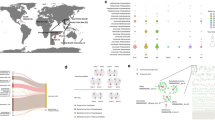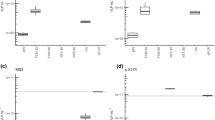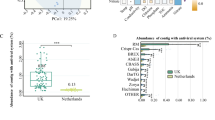Abstract
Viruses are the most abundant biological entities in aquatic environments, typically exceeding the abundance of bacteria by an order of magnitude. The reliable enumeration of virus-like particles in marine microbiological investigations is a key measurement parameter. Although the size of typical marine viruses (20–200 nm) is too small to permit the resolution of details by light microscopy, such viruses can be visualized by epifluorescence microscopy if stained brightly. This can be achieved using the sensitive DNA dye SYBR Green I (Molecular Probes–Invitrogen). The method relies on simple vacuum filtration to capture viruses on a 0.02-μm aluminum oxide filter, and subsequent staining and mounting to prepare slides. Virus-like particles are brightly stained and easily observed for enumeration, and prokaryotic cells can easily be counted on the same slides. The protocol provides an inexpensive, rapid (30 min) and reliable technique for obtaining counts of viruses and prokaryotes simultaneously.
This is a preview of subscription content, access via your institution
Access options
Subscribe to this journal
Receive 12 print issues and online access
$259.00 per year
only $21.58 per issue
Buy this article
- Purchase on SpringerLink
- Instant access to full article PDF
Prices may be subject to local taxes which are calculated during checkout

Similar content being viewed by others
Change history
06 September 2007
In the version of this article initially published, on p. 270, under “Equipment,” “Anodisc Al203 filters” should have read “Anodisc Al203 filters”. On p. 274, the second sentence of Step 21, which ended with “around the entire filter”, should have ended with “around the entire filter; i.e., if 3 boxes resulted in a count of 34 for the first field, then count 3 boxes in each of 9 other areas of the filter (do not count different numbers of boxes in different fields of one filter.” The third sentence ended with “viruses counted”; it should have ended with “viruses counted; therefore some fields may yield counts that are <30. But if the total count for a filter is <200, count extra fields.” In Step 22, the equation (X × 100)/(n × RSF)/V should have been RSF x X x (100/n)/V, and “counted on the microscope eyepiece 10 × 10 reticle grid” should have been “counted within the 10 x 10 reticle grid”. These errors have been corrected in all versions of the article.
References
Fuhrman, J.A. Marine viruses and their biogeochemical and ecological effects. Nature 399, 541–548 (1999).
Hara, S., Terauchi, K. & Koike, I. Abundance of viruses in marine waters: assessment by epifluorescence and transmission electron microscopy. Appl. Environ. Microbiol. 57, 2731–2734 (1991).
Noble, R.T. & Fuhrman, J.A. Use of SYBR Green I for rapid epifluorescence counts of marine viruses and bacteria. Aquatic Microb. Ecol. 14, 113–118 (1998).
Weinbauer, M.G. & Suttle, C.A. Comparison of epifluorescence and transmission electron microscopy for counting viruses in natural marine waters. Aquatic Microb. Ecol. 13, 225–232 (1997).
Hobbie, J.E., Daley, R.J. & Jasper, S. Use of nuclepore filters for counting bacteria by fluorescence microscopy. Appl. Environ. Microbiol. 33, 1225–1228 (1977).
Porter, K.G. & Feig, Y.S. The use of DAPI for identifying and counting aquatic microflora. Limnol. Oceangr. 25, 943–948 (1980).
Chen, F., Lu, J.R., Binder, B.J., Liu, Y.C. & Hodson, R.E. Application of digital image analysis and flow cytometry to enumerate marine viruses stained with SYBR gold. Appl. Environ. Microbiol. 67, 539–545 (2001).
Proctor, L.M. & Fuhrman, J.A. Mortality of marine-bacteria in response to enrichments of the virus size fraction from seawater. Mar. Ecol. Prog. Ser. 87, 283–293 (1992).
Hennes, K.P. & Suttle, C.A. Direct counts of viruses in natural waters and laboratory cultures by epifluorescence microscopy. Limnol. Oceanogr. 40, 1050–1055 (1995).
Brussaard, C.P.D. Optimization of procedures for counting viruses by flow cytometry. Appl. Environ. Microbiol. 70, 1506–1513 (2004).
Marie, D., Brussaard, C.P.D., Thyrhaug, R., Bratbak, G. & Vaulot, D. Enumeration of marine viruses in culture and natural samples by flow cytometry. Appl. Environ. Microbiol. 65, 45–52 (1999).
Tuma, R.S. et al. Characterization of SYBR Gold nucleic acid gel stain: a dye optimized for use with 300-nm ultraviolet transilluminators. Anal. Biochem. 268, 278–288 (1999).
Shibata, A. et al. Comparison of SYBR Green I and SYBR Gold stains for enumerating bacteria and viruses by epifluorescence microscopy. Aquatic Microb. Ecol. 43, 221–231 (2006).
Wen, K., Ortmann, A.C. & Suttle, C.A. Accurate estimation of viral abundance by epifluorescence microscopy. Appl. Environ. Microbiol. 70, 3862–3867 (2004).
Fischer, U.R., Kirschner, A.K.T. & Velimirov, B. Optimization of extraction and sediments of viruses in silty freshwater sediments. Aquat. Microb. Ecol. 40, 207–216 (2005).
Fuhrman, J.A., Liang, X.L. & Noble, R.T. Rapid detection of enteroviruses in small volumes of natural waters by real-time quantitative reverse transcriptase PCR. Appl. Environ. Microbiol. 71, 4523–4530 (2005).
Gregory, J.B., Litaker, R.W. & Noble, R.T. Rapid one-step quantitative reverse transcriptase PCR assay with competitive internal positive control for detection of enteroviruses in environmental samples. Appl. Environ. Microbiol. 72, 3960–3967 (2006).
Culley, A.I., Lang, A.S. & Suttle, C.A. High diversity of unknown picorna-like viruses in the sea. Nature 424, 1054–1057 (2003).
Culley, A.I., Lang, A.S. & Suttle, C.A. Metagenomic analysis of coastal RNA virus communities. Science 312, 1795–1798 (2006).
Griebler, C., Mindl, B. & Slezak, D. Combining DAPI and SYBR Green II for the enumeration of total bacterial numbers in aquatic sediments. Int. Rev. Hydrobiol. 86, 453–465 (2001).
Author information
Authors and Affiliations
Corresponding author
Ethics declarations
Competing interests
The authors declare no competing financial interests.
Rights and permissions
About this article
Cite this article
Patel, A., Noble, R., Steele, J. et al. Virus and prokaryote enumeration from planktonic aquatic environments by epifluorescence microscopy with SYBR Green I. Nat Protoc 2, 269–276 (2007). https://doi.org/10.1038/nprot.2007.6
Published:
Issue date:
DOI: https://doi.org/10.1038/nprot.2007.6
This article is cited by
-
Lysogenic bacteriophages encoding arsenic resistance determinants promote bacterial community adaptation to arsenic toxicity
The ISME Journal (2023)
-
Phage-microbe dynamics after sterile faecal filtrate transplantation in individuals with metabolic syndrome: a double-blind, randomised, placebo-controlled clinical trial assessing efficacy and safety
Nature Communications (2023)
-
Identification of a deep-branching thermophilic clade sheds light on early bacterial evolution
Nature Communications (2023)
-
Viruses affect picocyanobacterial abundance and biogeography in the North Pacific Ocean
Nature Microbiology (2022)
-
Enhanced mutualistic symbiosis between soil phages and bacteria with elevated chromium-induced environmental stress
Microbiome (2021)



